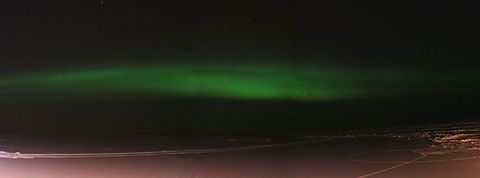

 | |||||||||||
|
|
Journals 2007/2008Jason Pavlich
January 6, 2007 Position 71° 32.559' N 125° 32.185' W I woke up today at 7:15, got dressed, and headed downstairs to meet Monika and Wojciech for breakfast. A breakfast sandwich, a cup of orange juice (to ward off scurvy), and 2 cups of coffee later I was back in my room getting dressed for the ice. On the ice, I generally wear two pairs of socks (one liner and one wool), long thinsulate underwear, fleece-lined pants, a fleece jacket, steel-toed insulated snow boots, a mustang survival suit (one piece waterproof snowsuit), 2 pairs of gloves (one liner and one ski), a fleece hat, and a fleece hood with neck and face protection. I sometimes feel like the little brother in that movie, "A Christmas Story", where if I fall on the ice, I will not be able to get back up.
It was really nice on the ice this morning, -20°C (-3.6°F) and snowing gently. The coring went relatively quickly. Today, we only needed 6 partial cores and 5 full-length cores, three holes for brine, two coolers of fresh snow, and two liters of surface water. I realized that I do not have many pictures of myself doing all of this work. I may have to hire somebody for the day to follow me around with a camera. After cleaning all of the equipment, the ice cores were sectioned, bagged and set to melt along with the snow. Later in the afternoon, filtrations were started on the surface water, ice, and snow samples. After lunch I helped Amanda again sectioning and shaving her ice cores in the -20°C room. The captain then showed some footage taken aboard back in October when a BBC reporter traveled with the Amundsen though the Northwest Passage from Resolute to the Amundsen Gulf. Everybody gathered in the officer's lounge got a good laugh when the reporter described the -10°C weather as "absolutely brutal." We wondered what he would have said if he were a few days ago when the temperature with the wind chill was -55°C. After dinner it was back out on the ice. The temperature had dropped to -24.3°C (-11.7°F) and ice was forming on my beard within a few minutes. But with only 15 knot winds and the northern lights on the horizon, it was nice to be working outside. I was back to me room by 10:30 when I noticed the northern lights reappear off the starboard side of the ship. I borrowed a tripod from Ramon Terrado, a graduate student from Laval University, and headed outside to try to take some pictures.
It is 12:30 am now and I am getting tired. I am looking forward to tomorrow morning and getting back out on the ice. I could work in a lab anywhere, but this is really why I wanted to come north. |
||||||||||

